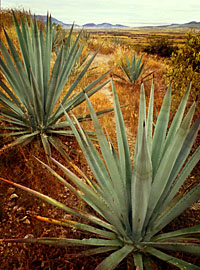The Desert
April 1990
The desert of the Valley of Oaxaca is peopled with birds, spectacular plants, and the ghosts of the ancient Zapotec...
Wow, I haven't been much for writing letters down here in Mexico (except to Rachel). I haven't even written my life long comrade Garth yet. It's a couple of things; one, I'm so busy living life that I seldom have time to stop and write about it. And two, when I do sit down to write I have so much to say and relate, so many experiences, thoughts and new insights, that I become instantly and thoroughly overwhelmed and drop my pen in brain-curdled frustration.
But today I took a bus out to the wild desert with its plateaus, arroyos,
cactus, sand, and vultures. I just started wandering into the hills with my
sombrero shading my face and a bottle of water, a cucumber and a melon in
my shoulder bag. I had a strong feeling of my father as a young geologist
wandering through the deserts of Nevada - appreciating all the incredible
beauty of the desert. Of course, here in Oaxaca there isn't even one sagebrush,
but enough cactus to make up for it. Anyway, I think wandering in the desert
under the sun alone must be a genetic thing. It certainly felt that way today
- enjoying the solitude and vastness of the landscape - enjoying my own company
and choosing my own paths through the wild lands.
 |
| Maguey on the mesa at Yagul |
The desert here is awe inspiring. It is so full of life - a wet desert. So
many kinds of cactus - huge organ pipes, several varieties of maguey from
which they make mescal and tequila, small cactus balls that almost jump onto
your legs, hitching a ride to a new home. The huge jutting stones: white,
grey, bright yellow and orange with lichens - rounded, pitted, beaten and
carved by the elements. And what amazed me most wasn't the soft red reflection
of the earth on the undersides of the clouds, nor the way the huge black-headed
vultures master the wind lift off the plateaus - what blew me away was finding
banana trees hidden deep in the corners of the stony canyons.
Today the desert didn't live up to its dry reputation, huge clouds welled up over the
mountains and dark thunder storms came rolling across the massive curve of the Oaxaca
Valley. I made haste off my stony perch on the roof of a vast mesa and scrambled down into
a more sheltered arroyo - a classic canyon filled with goats, sheep, burros and shepherd
boys and their dogs. Dogs not accustomed to white skin. Fortunately most Mexican dogs
understand well the gesture of bending over to pick up a stone.
I took myself and my well scratched legs into the wetter lowlands, the base of the
valley where all the water collects, along the fields of cane spotted with white egrets
bright against the dark fresh tilled soil, past campasinos plowing foot by foot with two
huge bulls and a wooden plow, along a trail with cattails and alfalfa on one side and
cactus and mesquite on the other. Up a little rise and suddenly I'm at Yagul - the ancient
remains of the religious center for a fortified Zapotec city. Here you can wander through
the ball court and leveled palace and look up onto the immense rock outcrops and see where
the stone walls still stand that kept at bay the marauding war parties from Monte Alban
and perhaps even Tenochitlan (Mexico City, Moctezuma's lair). The Aztecs were much hated
in most of Mexico - a wicked empire demanding staggering tribute foods and lives from most
of central Mexico's ancient tribes. The Spanish came and took everything, so giving
tribute ceased to be a problem - there was nothing left to give, not to mention that
Moctezuma and the Aztec empire were dead.
Well, anyway, I walked through the rain out to the main road and got on the next 50 cent bus that covered the 20 miles back to Oaxaca.
![]()
 |
 |
 |
Home |
Traditions Mexico Tours |
Talk to Us |